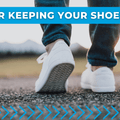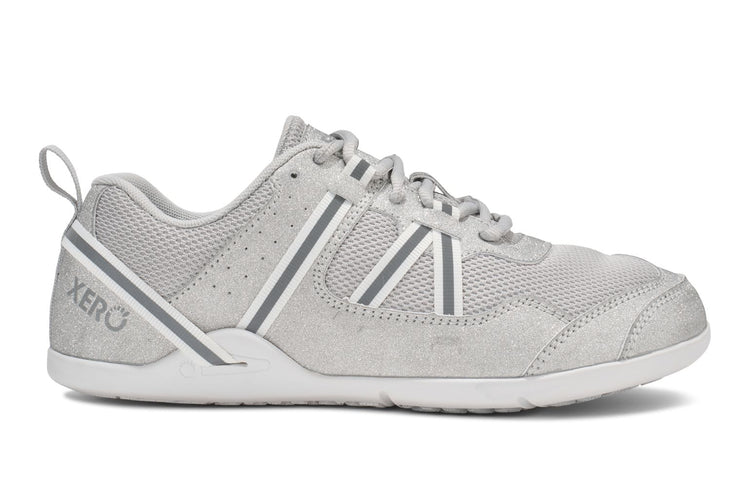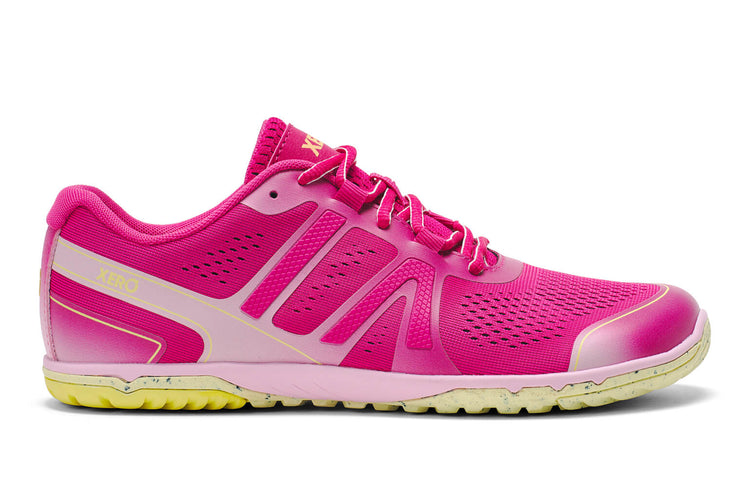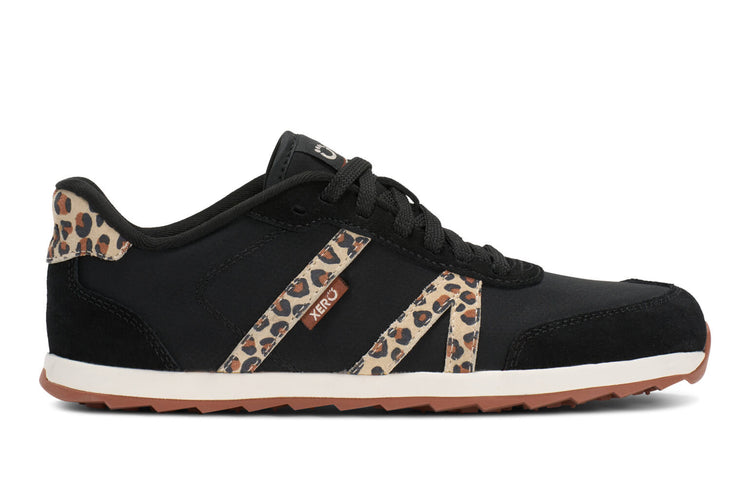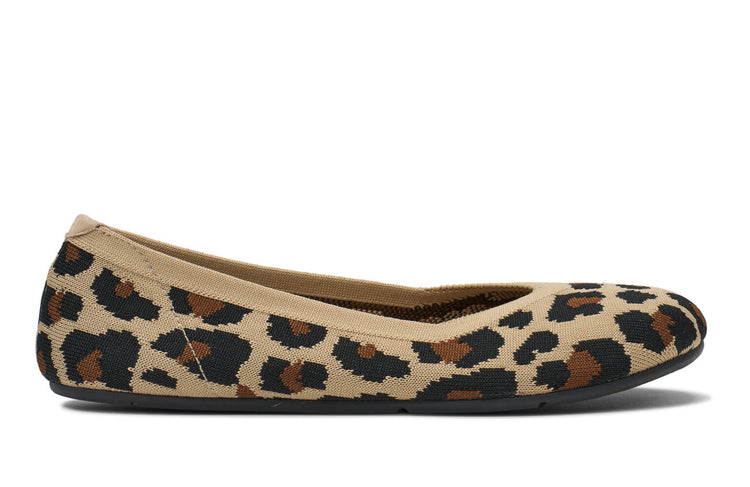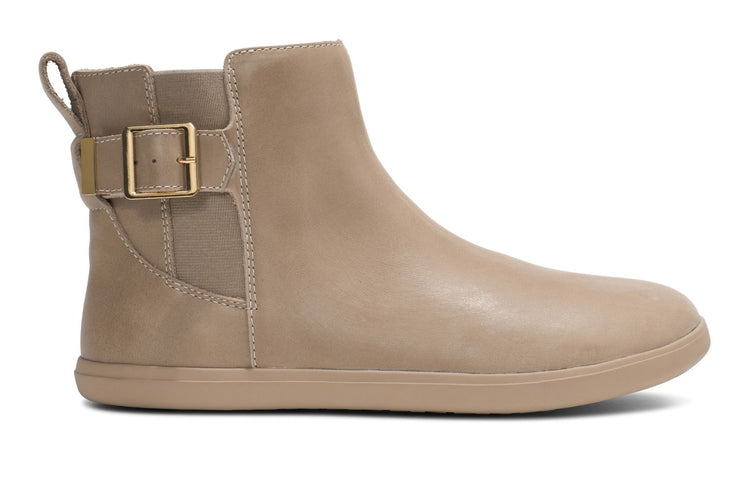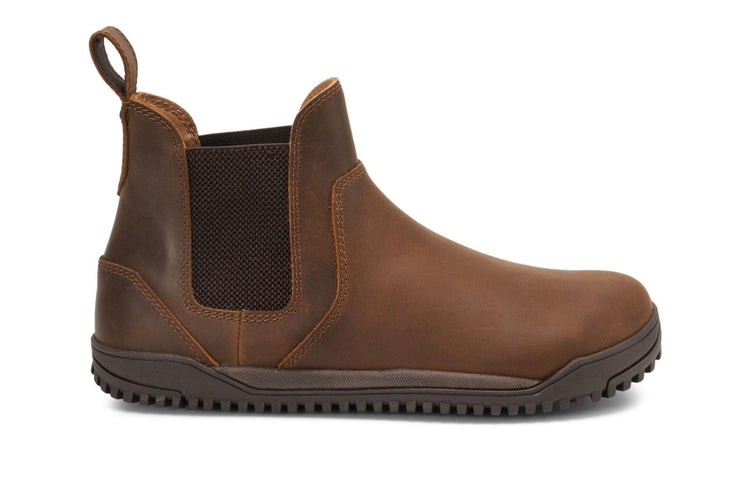“The Dream Shoe”: A Partnership with Xero Shoes & Born to Run 2 Authors
latest News
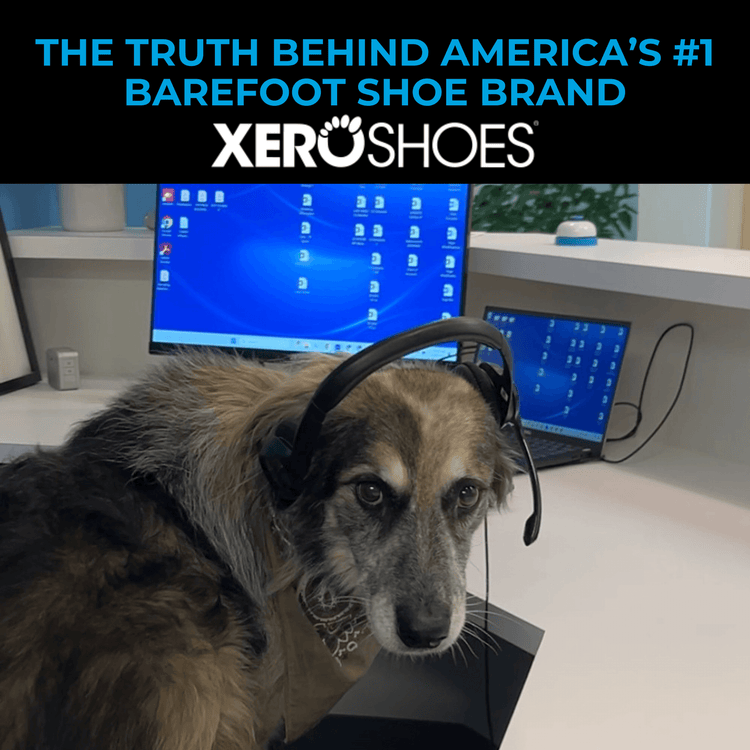
The Truth About America’s #1 Barefoot Shoe Brand
Building a barefoot shoe brand? Are we barking mad?Hidden camera footage. Go behind the scenes at Xero Shoes. WATCH HERE
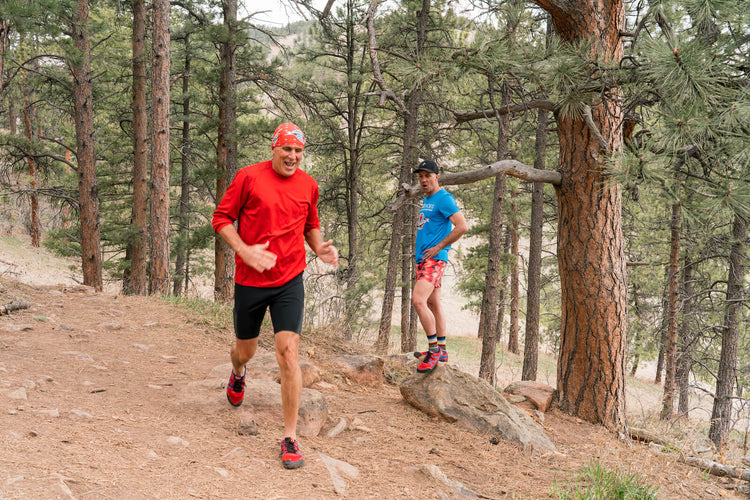
Year Zero with Born to Run
Year Zero for Christopher McDougall? He couldn't even run, let alone tackle a 50 mile race in the Copper Canyons with the Tarahumara.But then, he met Coach Eric Orton, who taught him the truth about running stronger: it starts with a 90-day reboot. That's exactly why the duo wrote Born to Run 2: The Ultimate Training Guide. Christopher's tale in Born to Run wouldn't have been written without guidance from Eric, a renowned running coach and ultrarunner himself. The sequel gives runners of all levels the tips they need to run faster and further, for longer. Runners often think of winter as a time to rebuild their base. But just as important as it is to ramp up mileage slowly, you need to focus on key elements: form, fitness, focus and footwear.So what is the 90-day Reboot? Anyone who gets a copy of the book gains access to Training Peaks, where you'll get a daily schedule of workouts, designed by Coach Eric.You'll learn form drills like: Rock Lobster to practice optimal running form and eliminate overstriding by running to the beat of the famous B-52s song while your Running Logs to increase cadence, proper foot strike, stance leg, and push off. 100 Up to train active muscle patterns in running, specifically for forefoot landing and knee drive. You'll also improve run-specific strength exercises (no weights required), through exercises like: Foot Core to stabilize from the ground and improve balance and foot strength. Run Lunges is the golden exercise for strength, stability, mobility, and arm synchronization. Single-Leg Wall Squats to restore equilibrium between your quads and glutes as you learn to initiate squat movement from your hips and glutes. A Sneak Peek of the #1 Exercise Runners Love in Born to Run 2:Special Born to Run Shoe + Book Bundle For a limited time during the month of December, buy a pair of Born to Run Xero Shoes (Mesa Trail II or Zelen), and get Born to Run 2: The Ultimate Training Guide, for $20. Click here
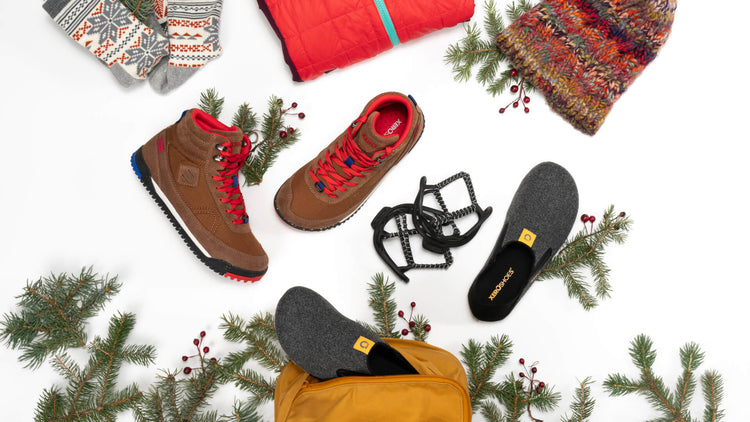
Best Gifts for Outdoor Enthusiasts: Guide for Men & Women
Find The Perfect Xero Shoe For Your Outdoor Adventurer If your outdoor-loving family and friends seem like they have all the gear they need – tents, stove, backpacks, jackets, etc – make their next outdoor adventure a little more comfortable with barefoot hiking shoes, boots, or sandals from Xero Shoes. Whether they backpack, camp, fish, trail run, surf, or snowshoe… they’re bound to be surprised. What makes Xero Shoes the perfect gift for outdoor enthusiasts? Our outdoor shoes, boots, and sandals are so that they’ll forget they’re wearing them. The wider, foot-shaped toe box and zero-drop sole makes it feel like you’re wearing nothing. Plus, Xero Shoes are the gift that lasts longer, since all shoes have a 5,000 mile sole warranty. Gift for the Stylish Hiker: Ridgeway The Ridgeway looks good and feels comfortable, perfect for that person who curates their hiking outfit and always looks put-together in their hiking photos. Waterproof suede keeps feet dry and a grippy sole performs on various hiking surfaces for epic pictures. Ridgeway - Men SHOP MEN Ridgeway - Women SHOP WOMEN Gift for the Camper: Sunrise For campers with chilly feet in the mornings or evenings, the Sunrise is easy to slip on or off when they're getting in and out of their tent. The microfiber suede feels so soft and is even water-repellant, so they don't have to worry about the morning dew. Sunrise -Men SHOP MEN Sunrise - Women SHOP WOMEN Gift for the Skier/Snowboarder: Alpine After a day of shredding the slopes, there is no better relief than taking off stiff, heavy boots. That's where the Alpine snow boot is like a welcome hug for tired feet. Plus the 200g/sq. in. polyester insulation, heat-reflective insole, and a fully seam-sealed lining give you the warmth your feet need. Alpine - Mens SHOP MEN Alpine - Womens SHOP WOMEN Gift for the Lightweight Backpacker: Scrambler Mid The Scrambler Mid is a “do it all” lightweight hiking boot for the hikers in your life who are always looking to shed weight without sacrificing performance. A Special Michelin sole differentiates this boot and makes it more agile, flexible and lighter than others. Scrambler Mid - Men SHOP MEN Scrambler Mid - Women SHOP WOMEN Gift for the Surfer or SUPer: Aqua Cloud Before hitting the water or waves, they will arrive at the beach in style with the color-popping Aqua Cloud. The adjustable straps ensure the best fit for any foot, and this sandal even floats, so if they drop it in the water they won't lose it. Aqua Cloud - Men SHOP MEN Aqua Cloud - Women SHOP WOMEN
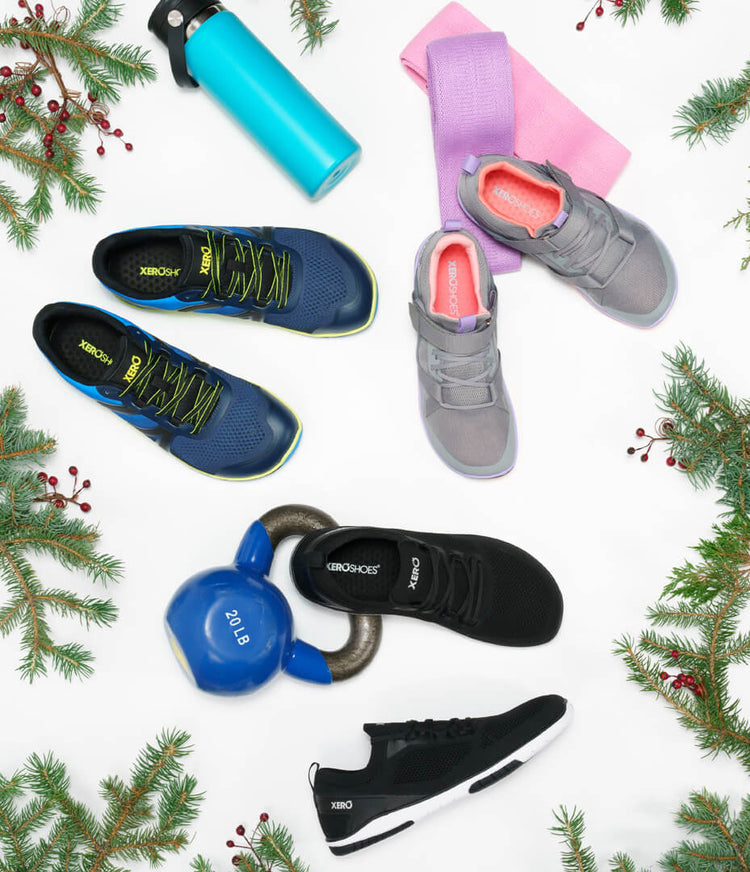
Best Gifts For Fitness Lovers: Xero Shoes Guide
Find A Xero Shoe For The Fitness Lover In Your Life If your fitness-loving family and friends have it all, skip the ordinary gifts and give them barefoot shoes from Xero Shoes. Whether they like to lift weights, play pickleball, run or tackle bootcamps, you can surprise them with a barefoot fitness shoe for any activity. What makes Xero Shoes the perfect fitness gift? Our workout shoes are designed to fit like a sock on your foot, featuring a comfortable wider, foot-shaped toe box and zero-drop sole. When you hit the gym in Xero Shoes, did you know that you’re working your feet just as well as your muscles? Barefoot strength training can offer better balance and stability, improved proprioception, and better form. Plus, Xero Shoes are the gift that lasts longer, since all shoes have a 5,000 mile sole warranty. Gift for the Lifter: Forza Trainer The award-winning* Forza Trainer is made for weight lifting and CrossFit. The bootie-style construction and instep strap provides a more custom fit, ensuring you stay stable and secure. *Awards: Women’s Health Sneaker Award, HEALTH Fitness Award, SELF Sneaker Award Forza Trainer - Men SHOP MEN'S Forza Trainer - Women SHOP WOMEN'S Gift for the Pickleball Player: 360º The 360º cross training shoe features responsive, omni-directional tread that gives you superior traction for lateral movement when you're cutting across the pickleball court. 360º - Men SHOP MEN 360º - Women SHOP WOMEN Gift for the Runner: HFS II The HFS II running shoe is an update to Xero Shoes' bestselling run shoe, to look even more stylish and versatile. The new tire-inspired outsole is great for runners who explore roads, gravel and dirt paths on their jaunts. A thin BareFoam™ layer adds extra protection. Featured in: Doctors of Running, Garage Gym Reviews HFS II - Men SHOP MEN HFS II - Women SHOP WOMEN Gift for the Stylish Gym-Goer: Prio Neo The Prio Neo is a sleek performance training shoe that’s ready for action at the gym, your bootcamp or CrossFit class. Breathable, moisture-wicking mesh keep feet cool for all-day comfort, so you can go from the gym to the rest of your day. Featured in:WIRED "Best Barefoot Shoes for Walking" and Men's Health"Best Minimalist Shoes." Prio Neo - Men SHOP MEN Pro Neo - Women SHOP WOMEN
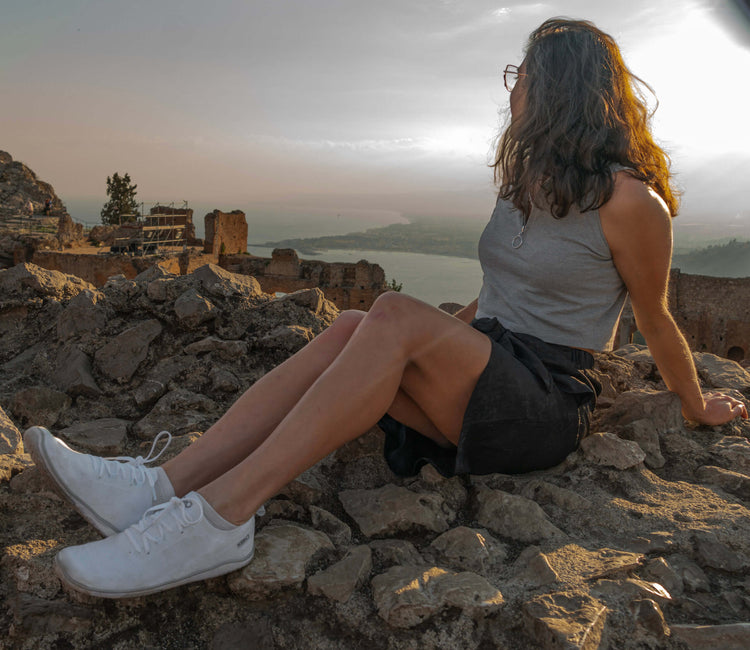
Shoes I Wore Traveling to Italy - Xero Shoes
Written by: Alexa Lampasona, PR Manager at Xero Shoes Alexa handles media relations and press for Xero Shoes. If you found Xero Shoes in a magazine, online article, TV segment, chances are Alexa made that happen! Alexa lives and breathes Xero Shoes, wearing them for running, hiking, walking the dog, hanging around town (in Boise, where she works remote), and travel. Read on to hear about Alexa's recent European vacation and how she wore Xero Shoes for everything... I recently traveled to Sicily with my husband for an anniversary trip. We intentionally went in the off-season and were met with fewer crowds and better deals on accommodations. Sicily in early October was pleasant and probably even more enjoyable with the temperatures. We lounged by the beach in 80-degree weather, and I wore shorts or dresses every day. When I'm packing for a trip, I always overpack, and since we were spending time on the coast and in the Etna mountain region, I had to have my beachwear and some mountainwear. My husband and I are also notorious for NOT relaxing on our vacations. Instead of wine tasting in the Mt. Etna region, I booked us to hike "for experienced hikers only" to the craters at the peak of Etna. But there's one item that I never have to overpack: my Xero Shoes. We hit several towns in Sicily, and I planned a myriad of outfits around my Xero Shoes Nexus Knit (and Z-Trail EV for the beaches): Skirts and crop tops for looking stylish in Taormina. Z-Trail EV with a bright dress for our beach days in Taormina Cool and breezy shorts and tanks for walking through Agrigento's Valley of Temples. Bright and cheery colors for Catania, one of Sicily's vibrant towns. Comfortable yet stylish neutrals for train travel. And an oversized shirtdress for our pizza tour in Naples. Xero Shoes Nexus Knit in all white paired perfectly with every outfit. It was the only shoe I packed (besides the Z-Trail EV for the beach) because: It was versatile - you can never go wrong with an all-white sneaker It was comfortable - my watch regularly logged us walking 10,000 steps, and I never once had to think about my shoes It was lightweight - my suitcase remained well under the airline weight limit When the white sneakers got a little smudged from walking around the ancient ruins, I just followed these tips to clean my white shoes. It was easy to wash them in the hotel sink and they dried overnight. In addition to the Nexus Knit, these other lightweight, easily packable sneakers from Xero Shoes pack just as well and will pair with any outfit on your next trip: Dillon Shop the Dillon Kelso Shop the Kelso Z-Trail EV Shop the Z-Trail EV
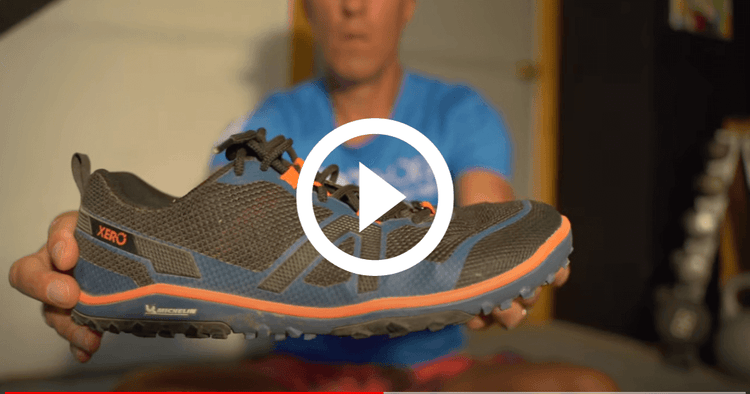
Running Coach and Author Eric Orton's Review of Scrambler Low
"The Scrambler Low performs exceptionally well on varying terrain, allowing me to go longer and stronger in a natural shoe." -Coach Eric Orton DISCOVER THE SCRAMBLER LOW
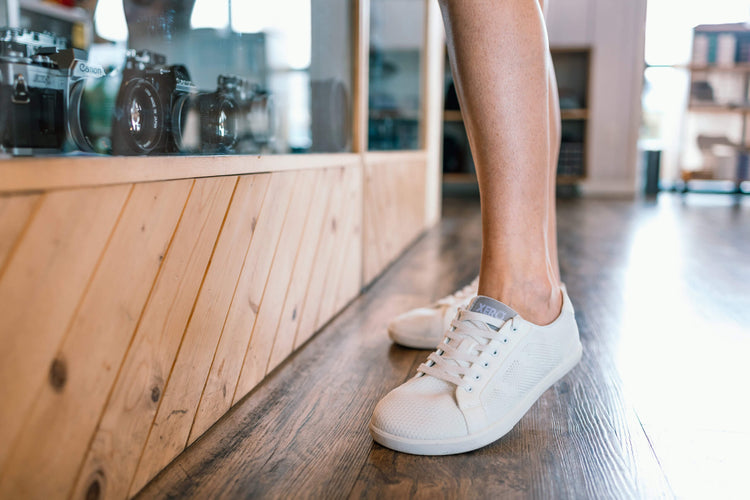
Best Shoes for Retail Workers? Try Barefoot Shoes
Going Minimal in Retail If your feet don’t feel as good at the end of a long shift – plus errands, social life, and the rest of your day – as they did at the start… then you’re wearing the wrong shoes. And what if the best shoe for all-day comfort is the exact opposite of what “Big Shoe” has been pitching? What if all the features they say should help you actually get in the way or even cause the problems they claim to cure? We’ve heard from thousands of people working on the retail floor that switching to “barefoot” or “minimalist” shoes has been the secret to happy, healthy feet. I know that can sound counterintuitive or even crazy, so don’t take our word for it. Here’s what some retail workers have to say about their experience with barefoot shoes: “I have had my Xero Shoes Prio Suede shoes for a little over 2 months. I work retail and walk on hard surfaces for 5 hours a day. I am 75 and this shoe has allowed me to make major gains in total flexibility particularly in my feet/ankles, knees and hips, while assisting in correcting my neck forward position and back posture. They are extremely comfortable and I almost don't want to take them off when I get home. My feet used to ache after work and now they feel great!” “I work in a large retail establishment and am on my feet and moving on concrete 8-9 hours daily. I have tried all the cushy over-supported shoes to no avail - dealing with foot pain and blisters. I met a customer in the store wearing Xero shoes and stopped him and asked about them. This led to me purchasing my first pair of Xero shoes. I am 7 days into my Xero experience and ALL my foot pain is gone!! The wider toe cavity was what my feet needed. Thank you Xero. I have already ordered my second pair. I think this is the beginning of a life-long friendship.” Let’s discuss what retail workers should know about barefoot shoes, and how they can help you enjoy healthy feet at work and at home. What Shoes Make Sense For Retail Workers? Before exploring the benefits of wearing barefoot shoes, let's first look at what shoes make sense for retail. As a retail employee, you expect a lot out of your footwear. You need high-quality shoes that will… allow you to move efficiently around the store. offer comfort for your long shifts whether you are serving customers, cleaning, carrying stock, and more. provide traction and stability, with good grip for slip resistance. be extremely durable. You need sturdy shoes for long hours, multiple days in the week. offer protection for your feet. Your shoes must protect your feet from various accidents or spills that occur in retail stores. look professional (that, of course, varies depending on where you work) be easy to clean and maintain (if your job gets messy) Why “Normal” Shoes Aren’t Cutting It For Retail Workers Before diving into the benefits of barefoot shoes for retail employees, it’s worth considering why someone would ditch traditional shoes. “Normal” shoes… Have a narrow, pointed toe box that squeezes your toes together, which can lead to foot problems and balance issues. Have a raised heel, which negatively affects your posture, putting strain on your ankles, knees, hips, and back. Have stiff soles which limits your feet’s natural movement, again impacting balance and agility. Have excessive padding, which mutes the feedback the nerves in your feet send to your brain… which interferes with mobility. Weaken the feet over time and lead to a reliance on external support, rather than allowing the feet to strengthen and become their own support system. Are heavier, which will weigh you down over the course of a day. All of these things can negatively impact your health and well being. What Retail Workers Should Know About Barefoot Shoes Barefoot shoes address the issues mentioned above. This type of shoe design… has a wider, foot-shaped toe box to allow your toes to spread naturally is low to the ground for balance, mobility, and agility has a non-elevated heel (“zero-drop”), so it doesn’t mess with your posture is flexible and allows for natural movement allows your feet to strengthen and become their own support is so lightweight, that many retail employees forget they’re wearing them! 3 Benefits Retail Workers Will Get With Barefoot Shoes Here are three great benefits retail workers can get wearing barefoot shoes: They are “Zero-Drop” Traditional shoes often have a significant difference in height between the heel and the toe. This is known as a shoe’s "heel-to-toe drop." This drop can be as much as 12 millimeters or more for “normal” shoes. Even a small “drop” shifts your center of gravity forward, and adjusting to that can put strain on your ankles, knees, hips and back. Barefoot shoes, however, have a uniform sole height without any variation between the heel and the toe (also known as “zero-drop”). These shoes allow retail workers a more natural posture and gait, promoting better alignment and balance as they work long hours on their feet. They Are (Very) Lightweight “Normal” shoes tend to be heavier and more cumbersome for retail workers who spend several hours standing and walking around. After a while, you may get used to this. But when you switch to a barefoot shoe, the difference becomes vividly clear. Barefoot shoes are lightweight. This makes them an ideal option for retail workers, nurses, food service workers, salon workers, and anyone else who has to stand all day. Instead of wasting energy dragging heavy shoes around all day, you can be light on your feet. You'll have more energy to help customers and do various tasks around the store. We’ve heard customers say they’ve forgotten to take their barefoot shoes off after they got home from a long shift. They’re that comfortable and lightweight. Your Feet Become Their Own Support There are several downsides to “normal” shoes with soles that don’t allow your feet to move or toes to spread. Wearing these shoes is like wearing a cast on your foot. It restricts your foot’s natural movement, reduces joint mobility, and can cause the muscles to weaken the longer you wear them. By comparison, barefoot shoes don’t provide any external arch support. While this may seem counterintuitive, wearing barefoot-style footwear allows the muscles and tendons in our feet to support the arch naturally. Research by Dr. Sarah Ridge shows that merely walking in barefoot shoes builds foot strength as much as doing a foot strengthening exercise program. Barefoot Shoes Vs. Minimalist Shoes for Retail Workers Are barefoot shoes and minimalist shoes really the same thing? Ideally, yes. Practically, no. People started using the term “barefoot shoes” back in 2008-2009. And, yes, it’s a bit of a contradiction. After all, you’re either barefoot, or in shoes. The idea is that “barefoot” shoes give you the comfort, benefits, and FUN of being barefoot, but with the protection, functionality, and style you want from a shoe. Some people, and some footwear companies, didn’t like the idea of bare feet… so they came up with “minimalist shoes.” And this makes sense because, compared to “normal” shoes, barefoot shoes are, in fact, more minimalist. They use fewer materials, they don’t have all the (not helpful) bells and whistles, and the term “minimalist” doesn’t make you think of hippies walking around with dirty feet. Lately, though, some companies are promoting “minimalist” shoes with the idea that they’re “not as barefoot” as barefoot shoes. They have a bit more padding, or more support, for example. Unfortunately for them, this study by Irene Davis suggests that those shoes are not only worse for you than truly barefoot shoes, but they’re worse than “normal” shoes, too! So whether you call them “barefoot” or “minimalist,” what’s important is the features described below. Many companies claiming to sell minimalist shoes actually sell “partial minimalist shoes'', which can be worse for your feet than both “barefoot” and “typical” shoes. At Xero Shoes, we provide truly minimalist shoes that feature a wide toe box, no unnecessary cushioning, and an extremely flexible sole that lets you safely feel the ground while offering a layer of protection. Xero Shoes: Perfect for Retail Workers For retail workers seeking a good pair of barefoot shoes, try our slip resistant Prio model, including the Prio Neo and Prio All Day. The Prio is a minimalist shoe that comes with a removable 2mm insole which you can use while you adjust the barefoot feeling. For retail workers who want the “closest-to-barefoot” experience, you have the option to take out the insole. This model is lightweight, flexible, and durable, and, like all Xero Shoes, they come with our 5,000 mile sole warranty. It’s the perfect choice for retail workers who need comfort when they spend long hours on their feet. The Prio isn’t the only shoe we have for retail workers. Browse all the shoes from Xero Shoes to find a style or shoe for you. When you switch to barefoot shoes, you’ll feel what you’ve been missing – NATURAL comfort, performance, and health… and you’ll Live Life Feet First! The information in this post does not take the place of medical advice. Only your doctor can provide advice, diagnosis, and treatment. Always consult a qualified health provider, such as a physical therapist, if you have questions about your health.
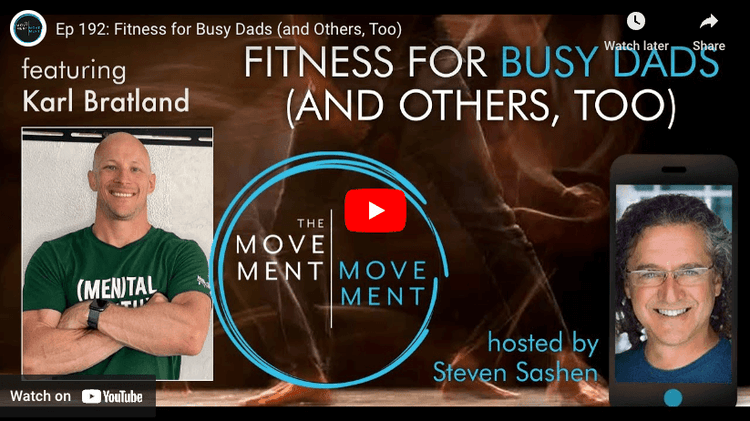
Fitness for Busy People: Finding Balance and Health
In a recent episode of "The MOVEMENT Movement" podcast, fitness expert (and Xero Shoes Affiliate) Karl Bratland, talks to Xero Shoes CEO Steven Sashen about the challenges of aging and how people of different ages can meet their unique fitness needs and goals. While Karl specializes in helping busy dads achieve their fitness goals, these principles of fitness and longevity apply to everyone. Here are the key takeaways form the conversation: 1. Adapt to Your Lifestyle: Tailor your fitness routine to fit your daily life and commitments. Recognize that one-size-fits-all approaches may not work in the long run. 2. Prioritize Health over Aesthetics: Understand that a healthy body is more important than fitting a specific image. 3. Create Lifelong Habits: Consistency is key; make exercise a natural part of your daily life. 4. Embrace Functional Fitness: Focus on exercises that enhance your ability to perform daily tasks. 5. Enjoy the Process: Choose fitness activities that you genuinely enjoy. 6. Set Realistic Goals: Celebrate your progress along the way to stay motivated. Listen to the full episode of "The MOVEMENT Movement" podcast. No matter your age, you'll walk away with some great takeaways from this conversation. LISTEN HERE Xero Shoes For Every Fitness Journey 360 BUY HERE Forza Trainer BUY HERE Prio Neo BUY HERE Prio BUY HERE HFS II BUY HERE Speed Force II BUY HERE
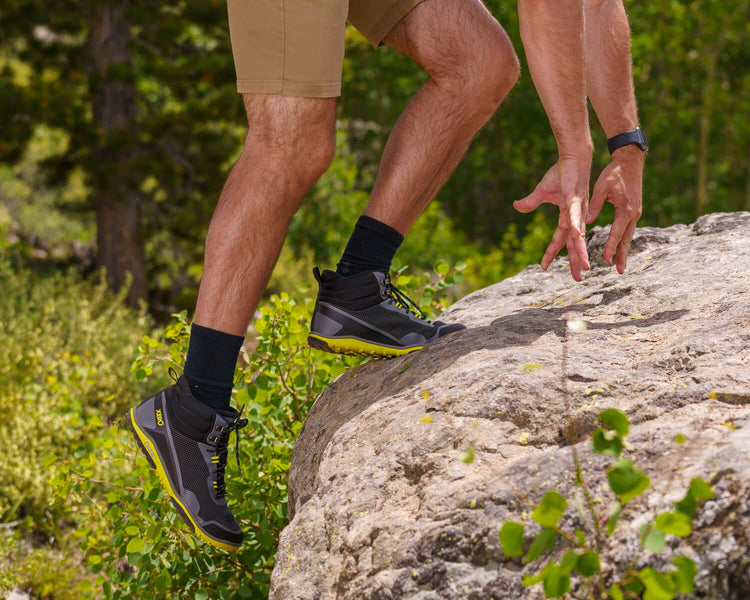
Xero Shoes Lightweight Hiking Boots are Under 14oz
When you’re out on the trails, you need a hiking boot or shoe that is lightweight but still offers support and protection from the elements, whether that’s a creek crossing or a rock scramble. Xero Shoes has a range of lightweight hiking boots that are designed to provide a barefoot-inspired experience, allowing your feet to move, bend, and flex naturally. These boots are perfect for hikers who want to forget they're even wearing boots. While most hiking boots may take some time to get used to, there’s no break-in period for Xero Shoes barefoot hiking boots, because the boot’s design naturally fits your feet with a wider, foot-shaped toe box and non-elevated heel. That means your toes will spread out instead of scrunch together, providing balance when rock scrambling or dodging roots. Hikers who have tried Xero's hiking boots have praised their comfort, flexibility, and durability. The boots are perfect for beginners and experienced hikers who want to explore the great outdoors comfortably. Xcursion Fusion Waterproof Hiking Boot The Xcursion Fusion hiking boot keeps your feet dry with a fully waterproof design, including a seam-sealed inner bootie and water-resistant membrane. While these are barefoot hiking boots and provide a balance of ground feedback, an embedded foam layer adds comfort and protection. SHOP Scrambler Mid Ultralight Hiking Boot The Scrambler Mid has a thin layer of fiberlite technology in the Michelin sole that gives the boot unparalleled strength, flexibility and lightness. Rounding out the ultralight hiking boot are truncated lugs inspired by mountain bike tires, guaranteeing grip and shedding mud on any hiking adventure. SHOP Ridgeway Stylish Waterproof Hiking Boot As stylish as they are functional, the retro-inspired Ridgeway hiking boot is versatile, whether you’re doing an all-day hike or going to a brewery. The rugged canvas upper with suede accents are waterproof for wet days on the trails. The durable sole's regrind rubber flecking looks great but also provides traction on the trails. SHOP
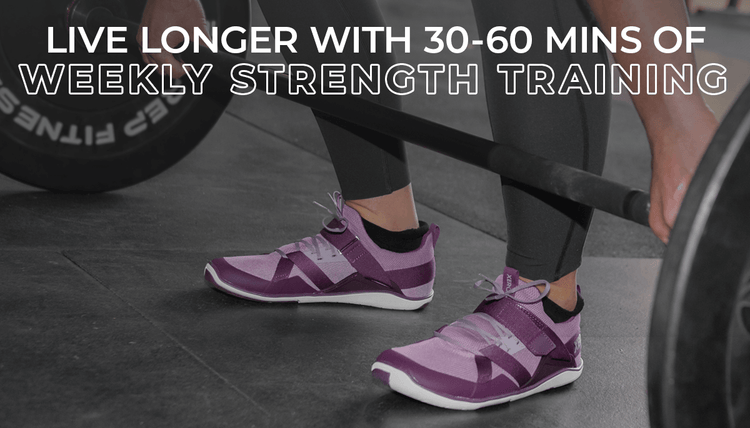
Can You Live Longer With 30-60 Minutes Of Weekly Strength Training?
A recent article in the British Journal of Sports Medicine shows that just 30 to 60 minutes of strength training per week can reduce your risk of dying from all causes by 10 to 17 percent. In this blog post, you’ll discover the key takeaways from this exciting research and understand the incredible benefits of strength training. THE BIG DISCOVERY This article reports something incredible: as little as half an hour to an hour each week of strength training exercises significantly reduces the risk of dying from all causes. STRENGTH TRAINING – WHAT IS IT? First things first, let’s clarify what strength training actually means. Strength training typically can include activities like lifting weights, using resistance bands, or doing bodyweight exercises like push-ups and squats. THE AMAZING BENEFITS OF STRENGTH TRAINING So, why should you consider adding some strength training to your weekly routine? Aside from this article, there are other well-known benefits to strength training. Reduced Mortality: The most significant finding of this study is that people who did 30-60 minutes of strength training per week were 10-17 percent less likely to die from all causes. Stronger Muscles and Bones: Strength training helps you build and maintain muscle mass. As you age, this becomes especially important as it can help prevent muscle loss and keep your bones strong. Read more in this Harvard Health article. Better Metabolism: Building muscle can also boost your metabolism, which means you burn more calories even when you’re not working out. This can be helpful for weight management. Read more from this article in the National Library of Medicine. Enhanced Quality of Life: Stronger muscles can make daily activities easier, improving your overall quality of life. Whether it’s lifting groceries, climbing stairs, or playing with your kids, strength training can make everything feel more manageable. Learn more in this article posted on Harvard Health. HOW TO GET STARTED WITH STRENGTH TRAINING Getting started with strength training doesn’t have to be complicated or require a gym membership. You can begin with simple bodyweight exercises at home or invest in some resistance bands. Start slow, focus on proper form, and gradually increase the intensity as you become more comfortable. Remember, it’s not about how much you lift; it’s about being consistent and gradually progressing over time. IN CONCLUSION Strength training isn’t just for bodybuilders or athletes; it’s a simple and effective way for everyone to improve their health and longevity. Spending just 30-60 minutes per week on strength training exercises can have a significant impact on your overall well-being and help you enjoy a longer, healthier life. So, why not start today? Your future self will thank you! XERO SHOES FOR ENJOYABLE STRENGTH TRAINING Browse our footwear, or learn more about the benefits of barefoot shoes for weight lifting.
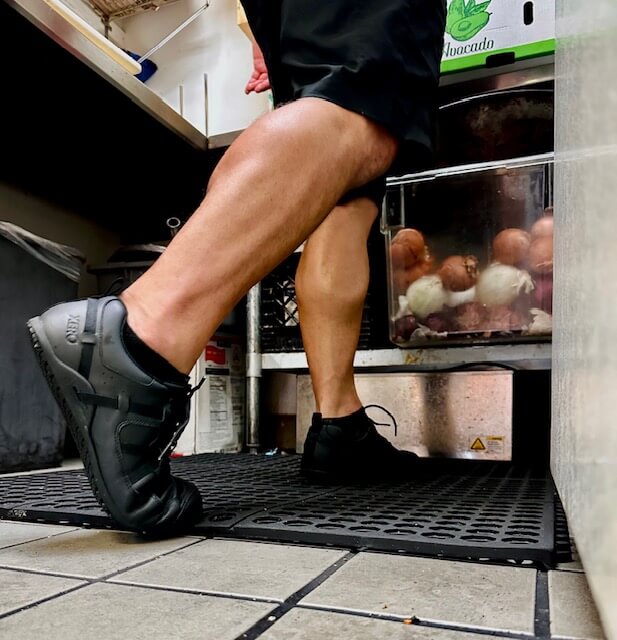
How Food Service Workers Can Find Comfortable Shoes
Food service workers spend long hours standing and moving around, which puts big demands on their feet. Whether you work in the kitchen or wait tables, your shoes should provide comfort during your shift. Having strong, healthy feet that feel good at the end of a shift starts with picking the right shoe. You're about to discover that what most people think are the best shoes for service workers, could actually be the cause of the foot, knee, hip, and back issues that you feel at the end of a double. Then you’ll find the (possibly surprising) best shoes for food service and restaurant workers. What is The Best Shoe for Restaurant Workers? The ideal shoes for service industry workers go beyond simply providing comfort. They are shoes designed to enhance your performance in fast-paced and dynamic food service environments and, ideally, leave your feet and the rest of your body feeling good at the end of the day. The best shoes for food service workers have the following qualities: Non-slip: Slip and fall accidents are the most common injury among kitchen staff, due to contact with wet, slippery, and greasy surfaces. Employees should have a good pair of slip-resistant shoes that have tread for increased grip and traction. Comfortable: For food service employees working long shifts and on their feet all day, shoes should offer natural comfort. Servers, in particular, will rely on comfortable shoes as they walk from table to table. But, as you'll see, genuine comfort may come from a different source than you think. Lightweight: This one is simple. The heavier the shoe, the more energy you use to move your legs. The lighter the shoe, the better you can feel. Durable: Service workers wear shoes for long shifts, and for months at a time. Long-lasting shoes will cost food service employees less in the long run, by not having to frequently get replacements. Protective: shoes must protect your feet from all kinds of spills and other accidents. Easy to clean: Whether you're doing customer service or food preparation, your shoes can get messy fast. You need to be able to clean them after stepping on dropped food items or spilling Table 5's drinks on yourself. So what kind of work shoes offer all these features and even some additional benefits? Contrary to what many people believe, but now thousands of service workers have discovered, barefoot shoes give you all the features and benefits above. I’m a chef and I spend all day on my feet. I’ve tried everything from clogs, boots, memory foam, you name it. I wear a minimalist / barefoot shoe to the gym and I was thrilled that there is a version I could wear to work. Light, comfortable, easy for a 12-14+ hour day. These are hands down my favorite shoes and I have been telling everyone that will listen that they should try them. Why Barefoot Shoes for Food Service Staff? Many food service workers may have heard of “barefoot shoes”, but may not understand how they differ from traditional shoes and why those who’ve made the switch will never switch back. Barefoot shoes give restaurant and food service industry workers: Natural comfort. Working in food service, you’ll need comfortable shoes as you move around or carry heavy plates. Traditional shoes have narrow toe boxes that cause pressure and discomfort. Barefoot shoes feature wider, foot-shaped toe boxes that let your toes wiggle and move freely, offering maximum comfort and improved balance and stability. Proper posture. Shoes with a thick sole can affect your balance by elevating your center of gravity and reducing sensory feedback you receive touching the ground. Barefoot shoes have a thin, protective sole that keeps your foot completely level to the ground, letting your body have natural posture. Agility and mobility. You have over 200,000 nerve endings in each foot! This is so your brain can feel what you're stepping on or in, and then tell your body how to move effectively and efficiently. Typical shoes with thick and stiff soles block your feet from being able to feel the ground beneath you. Food service jobs demand quick movements, precise footwork, and the ability to navigate crowded spaces. Barefoot shoes, with their thin and flexible soles, offer a heightened proprioception and sensory feedback to make you more nimble. Lightweight. Barefoot shoes weigh much less than anything else you've put on your feet, so you're spending less energy throughout your shift. Imagine coming home from doing a double and forgetting that your shoes are even on your feet because they're so comfortable and lightweight. The Perfect Shoe For Food Service Employees Introducing The Prio All Day SR The Xero Prio All Day SR is a non-slip barefoot shoe worn by many in the food service industry. Food service or restaurant employees – from chefs and cooks to waiters and bussers – will love the feel of these shoes. That’s why America's number one barefoot shoe company made this specific shoe, at the request of thousands of food service workers. Here are some great features that the Prio All Day SR offers: A wider, foot-shaped toe box that lets your toes spread, relax and move freely Zero heel-to-toe drop for proper posture Thin, flexible sole for enhanced balance, agility, and mobility Non-slip tread for grip on wet, oily, and slippery surfaces, so chefs, food prep and other kitchen workers better avoid the risk of a slip and fall accident. Durable black leather is protective, easy to clean, and matches any outfit Lightweight. A men’s size 9 is 9.1 ounces per shoe, and a women’s size 7 is 7.5 ounces per shoe. They are so light, you won’t even notice you have them on during your shift! Don’t just take our word for it… Food service and restaurant staff members rely on wearing the Prio All Day SR: I bought these shoes for waiting tables. My last pair of shoes had me barely able to walk after the ride home from work. My first day with my all day Prios after returning home from a 13 hour double and I did jumping jacks! I have been doing several things in my life, living barefoot while guiding students at a survival school, a ballet dancer as a child/teen, and every position you can think of in a restaurant for the past 26ish years, and these shoes are the best I have EVER had. I’m a chef de partie in a restaurant and I ordered these shoes to use as a kitchen shoe. Kitchen shoes have to be waterproof and anti-slip and these are great. I just had to get used to that more leather feeling than the breathability of other xero shoes. But once they break in they're extremely comfortable and it's easy to forget you have them on. A great shoe for someone with a job like me. Read more reviews about the Prio All Day SR from men and women! Stay Comfortable and Safe Wearing Barefoot Shoes Wearing barefoot shoes, you can keep working those long shifts and stay on your feet for hours on end. The Prio All Day SR has everything you need in a food service shoe. Your feet and body will thank you! Prio All Day SR Men | Prio All Day SR Women
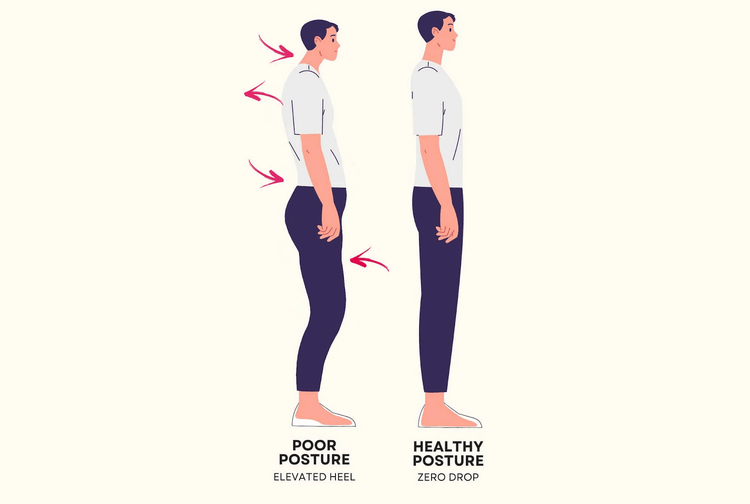
Can Barefoot Shoes Help with Posture? What to Know
How Can Barefoot Shoes Help With Posture? Excellent posture is not just about your physical appearance - it’s a cornerstone of your long-term health. And believe it or not, the secret to achieving better posture lies beneath your feet. The footwear you choose can negatively impact your posture. The right type of shoes can help correct posture, providing comfort and better alignment for your body. Let's take a look at posture to see how the wrong footwear can cause problems, and how the right footwear could help your posture. What Does Healthy Posture Look Like? Proper posture means that your spine should be properly aligned when you stand. There are natural curves in your lower back, mid back, and neck, but excessive curvature in any of those places or flattening in any of those places can be problematic. There are two types of posture: dynamic and static. Dynamic posture is how your body aligns during movement, for instance, walking, running, or bending over to pick up something. Static posture is how your body aligns when you are not moving, like sitting, standing, kneeling, or lying down. How Bad Posture Affects the Body Many people take good posture for granted until they notice negative effects. Poor posture can have far-reaching consequences that affect our physical well-being. Here are some of the effects of bad posture to be mindful of: Misalignment of the musculoskeletal system Poor circulation Imbalances in the body Pain in the back or neck Increased number of injuries Stress on the ligaments and joints Lack of range of motion Decrease flexibility Tight muscles Weakened muscles Difficulty breathing Poor balance Decreased efficiency in daily life or athletic performance What Causes Bad Posture? Several factors contribute to poor posture. You may be doing some of these things and not even realize it. Here are some common causes of poor posture: Prolonged periods of sitting: Having a sedentary lifestyle, you spend prolonged periods sitting or hunching over a desk, which can negatively affect posture over time. Not getting enough exercise can weaken the muscles that support your posture. Carrying excess body weight can strain the musculoskeletal system. Poor ergonomics in the workplace. This can commonly include improper desk setup, sitting for long periods of time, or incorrect positioning of computer screens. Sleeping position: Sleeping in positions that do not support proper spinal alignment. Stress, anxiety, and emotional tension leads to muscle tightness and increased muscle tension. Wearing improper footwear. Shoes can affect posture, disrupting your foot's natural ability to offer a stable base for your body. At this point, you may be thinking, “what is improper footwear?”. We’ll review characteristics of shoes that can negatively affect posture, and what kind of footwear can help you have correct natural posture. The Problem With “Normal” Shoes Many “regular” shoes can actually cause posture problems.. Here’s how shoes can impact posture: Elevated heels of “normal shoes” move your center of mass forward. This alters the body's natural alignment and can put extra pressure on the balls of the feet, ankles, hip, knees, or back to adjust for that change in center of mass. Padding that “normal shoes” typically have can negatively affect your posture. When foam cushioning wears out unevenly it can misalign your feet and ankles, which creates issues for your knees, hips and back. The narrow toe box of most conventional shoes can squeeze toes together and hinder natural toe splay. This can affect the overall stability of the feet, affecting the body's balance and posture. Thick, Stiff Soles reduced sensory feedback affecting proprioception and balance. Your feet need to provide sensory information to your brain so you can move your body effectively and efficiently. When we lose touch with the ground, our body may lose its ability to make micro-adjustments that help us maintain proper dynamic posture. How does this compare to barefoot shoes? They don’t have these issues. How Barefoot Shoes Can Help With Posture Barefoot shoes are designed to help improve your posture. While regular shoes can negatively impact posture, barefoot shoes mimic the feeling of being barefoot while providing the appropriate protection for your feet. Barefoot shoes can help improve posture in a few ways: No Heel-Toe Drop: Most shoes have an elevated heel, which shifts your center of mass forward. This forces you to adjust with your ankles, knees, hips, and back. Where you will feel the stress depends on which one of these joints is least supported by your muscles, ligaments, and tendons. Barefoot (or “minimalist” ) shoes do not elevate the heel. This can keep the body in a neutral alignment and keeps the body weight centered over the feet. Thin (but protective), Flexible Soles: Barefoot shoes have a thin yet protective sole, so you can safely FEEL to ground and give your brain the feedback needed to make dynamic postural changes. Wider, Foot-Shaped Toe Box: In the same way spreading your fingers provides balance doing pushups, spreading your toes provides you with better balance while you stand, walk or run. Barefoot shoes feature a wider toe box, which gives your toes the freedom to spread out for better balance, stability, and posture. Additional Tips to Improve Posture Aside from wearing barefoot shoes, here are some other tips to improve your posture that you can begin including in your daily routine: Be Mindful: Being aware of your posture, whether sitting or standing, is essential. Take a moment to check in with your body throughout the day. Make sure your body is properly aligned. Take Regular Walking Breaks: If you have a sedentary desk job, it's important to incorporate movement throughout the day. Set reminders to get up and take short walks, stretch, or do simple exercises. Vary your movements: By doing a variety of movements, you can help strengthen the muscles that support proper posture. This promotes muscle balance, flexibility, and core stability - all of which contribute to improved posture. Maintain a Healthy Weight: Carrying excess weight can place additional stress on your muscles, joints, and ligaments, affecting your posture. Strive to maintain a healthy weight through a balanced diet and regular exercise. What people are saying about improved posture and barefoot shoes from Xero Shoes.. “I work as an ER charge nurse and I’m on my feet nonstop for 12 hour shifts. I recently purchased the prio shoes to use for work and they have been amazing. I was even told that I appear to be walking with better posture. Hopefully I can help others discover the benefits of these shoes.” “I’m on my feet for 12+ hours and I needed shoes that give my feet plenty of support and that fit my foot. The barefoot feeling is ideal for my posture and for the anatomy of my foot. This is my second pair of Xero shoes and they did not disappoint!” Making the Switch to Barefoot Shoes If you’re ready for improved posture, it’s time to slip into a pair of barefoot shoes. Switching from a “normal” shoe to a barefoot shoe may be a bit of an adjustment, given the differences between the two. The phrase “transition slowly” is a common recommendation people will tell you. And while this isn’t wrong, transitioning to barefoot shoes is less about how quickly or slowly you make the change, and more about HOW you make the transition and not the length of time it takes. FEEL What You’ve Been Missing; Natural Comfort, Posture, and Health Barefoot footwear helps you FEEL the ground you’re walking on, and comes in many different styles of shoes, sandals and boots. Not sure what type or style of shoe you want? Use this shoe finder quiz to find a few recommended shoes for you. The content of this post does not constitute and is not intended to be a substitute for professional medical advice, diagnosis or treatment. Always seek the advice of a physician or other qualified health provider with any questions or concerns you may have about your health or a medical condition.



